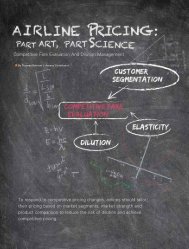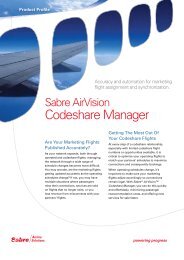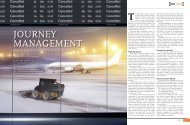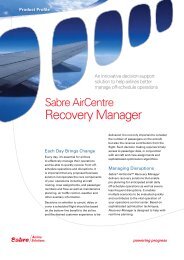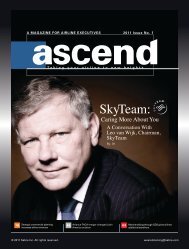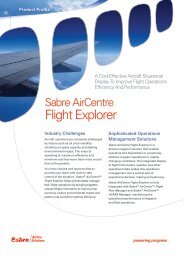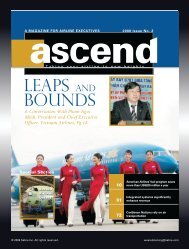2009 Issue 1 - Sabre Airline Solutions
2009 Issue 1 - Sabre Airline Solutions
2009 Issue 1 - Sabre Airline Solutions
You also want an ePaper? Increase the reach of your titles
YUMPU automatically turns print PDFs into web optimized ePapers that Google loves.
<strong>Airline</strong>s live and die by the strength of<br />
their network. Therefore, they need<br />
to relentlessly ensure that their routes<br />
maintain an acceptable return for their investment.<br />
With this in mind, airlines should always<br />
seek ways to strengthen their networks<br />
through the addition and deletion of routes as<br />
well as strong codeshare relationships.<br />
Deciding which changes are beneficial<br />
can be very difficult, if not impossible, to<br />
determine completely. There are many factors<br />
that go into this type of decision and, unfortunately,<br />
many of the drivers are constantly<br />
changing. With such a huge economic impact<br />
on the airline, the decision to change service<br />
must be examined in detail with a process<br />
that is dynamic enough to stay ahead of the<br />
changes in the marketplace. Knowing this, the<br />
ever-important task remains in deciding how<br />
or when to change the network. Fortunately,<br />
there are some universal guidelines to follow<br />
when making network modifications.<br />
Adding flights<br />
The goal to increase profits is usually<br />
dependent on the strength of the airline’s<br />
network. The question then arises, how does<br />
an airline identify flights to add and then<br />
judge if the flight is beneficial? There are<br />
several factors to consider before adding a<br />
flight. Before proceeding too far, the airline<br />
must verify that it has proper authority to add<br />
the flight. Restrictions exist between most<br />
countries limiting new service into a country<br />
and, depending on the location, domestic<br />
restrictions may exist as well. In addition, an<br />
airport may have its own constraints such as<br />
slots or heavy congestion that may influence a<br />
new route opportunity. However, the question<br />
remains, assuming the authority exists and the<br />
airport can support the new service, how are<br />
opportunities identified and then measured for<br />
profitability?<br />
One of the more common ways to identify<br />
opportunities is through the use of marketing<br />
information data tapes, or MIDT, which<br />
will identify how traffic has historically flowed<br />
between origins and destinations. Additionally,<br />
it allows the comparison of month-over-month<br />
and year-over-year data to establish trends.<br />
When using MIDT data, an airline should keep<br />
in mind that the data is based on bookings<br />
not actual flown passengers. Many airlines<br />
have processes in place to adjust the booking<br />
data to an estimation of traffic data by incorporating<br />
other data sources into the process.<br />
When using MIDT data, it is also helpful to<br />
pair the nonstop capacity with the origin and<br />
destination. This gives a feel for the traffic in<br />
the market as well as for the capacity in the<br />
nonstop market. Markets with far more traffic<br />
than nonstop capacity are likely to be good<br />
opportunities.<br />
If a carrier does not have access to MIDT,<br />
there are other ways to help identify opportuni-<br />
41



